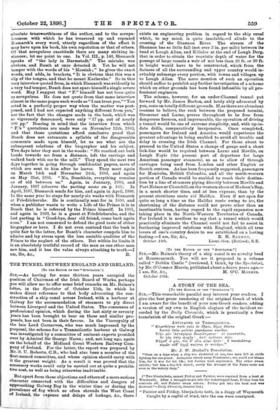am, Sir, &c., B.
THE TUNNEL BET VirEEN ENGLAND AND IRELAND.
[TO THE EDITOR OF THE "SPECTATOR:]
Sin,—As having for some thirteen years occupied the position of Chairman of the Irish Board of Works, perhaps you will allow me to offer some brief remarks on Mr. Bainee's ietter, in the Spectator of October 15th, in which he makes direct reference to that body advocating the con- struction of a ship canal across Ireland, with a harbour at Galway for the accommodation of steamers to ply direct between Liverpool and the United States. The consensus of professional opinion, which during the last sixty or seventy years has been brought to bear on these and similar pro- posals, has not been in their favour. In the Viceroyalty of the late Lord Carnarvon, who was much impressed by the proposal, the scheme for a Transatlantic harbour at Galway was investigated by a committee of eminent experts presided over by Admiral Six George Nares ; and, not long ago, again on the behalf of the Midland Great Western Railway Com- pany of Ireland. For the latter, the report was prepared by Mr. S. U. Roberts, C.B., who had also been a member of the first-named committee, and whose opinion should carry with at the greatest weight. As a result it was proved that the necessary works could only be carried out at quite a prohibi- tive cost, as well as being otherwise inadvisable.
But apart from these objections and others of a more serious character connected with the difficulties and dangers of approaching Galway Bay in the winter time or during the prevalence of fog which so often shrouds the West Coast of Ireland, the expense and delays of lockage, &c., there exists an engineering problem in regard to the ship canal which, to my mind, is quite insoluble,—I allude to the crossing of the Shannon River. The stream of the Shannon has so little fall (not over 3 in. per mile) between its head at Lough Allan, and Killaloe at the end of Lough Berg, that in order to obtain the requisite depth of water for the passage of large vessels a weir of not less than 28 ft. or 30 ft. in height would have to be constructed, which from the flatness of all the surrounding and upper country would in- evitably submerge every portion, with towns and villages, up to Lough Allan. The mere mention of such an operation should suffice to prohibit any further investigation of a scheme which on other grounds has been found infeasible by all pro- fessional engineers.










































 Previous page
Previous page